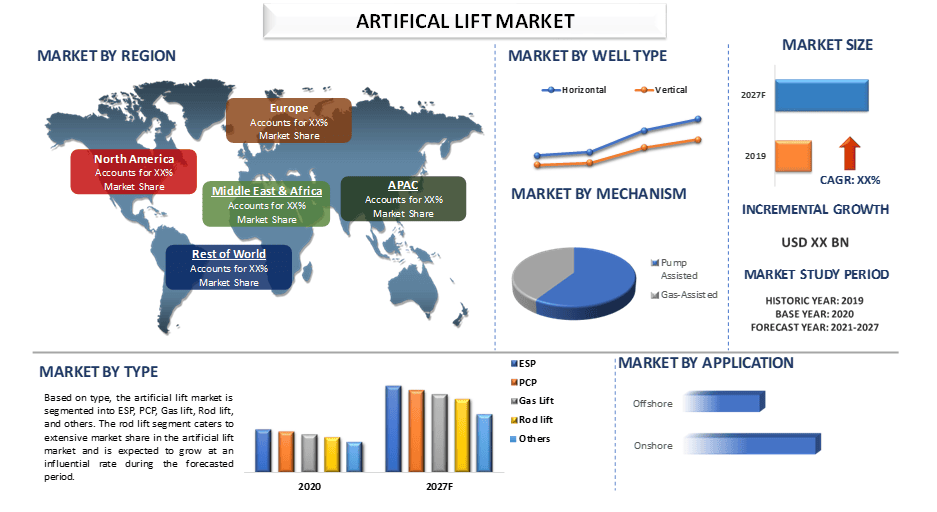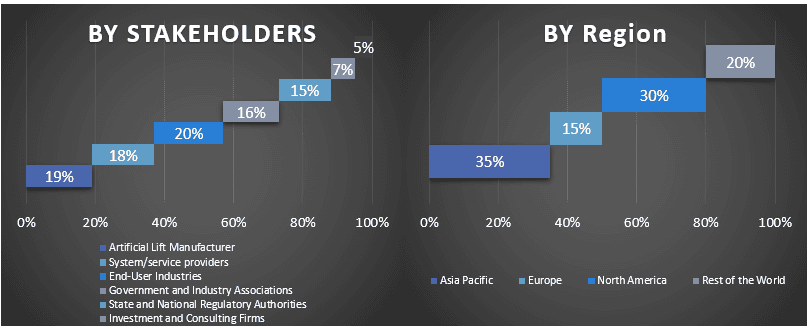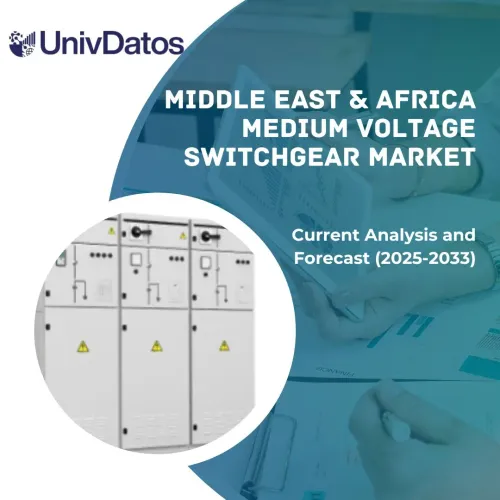
글로벌 인공 양수는 2021년에 약 95억 달러로 평가되었으며 예측 기간(2021-2027) 동안 6% 이상의 연평균 성장률로 성장할 것으로 예상됩니다. 인공 양수 시장 수요는 수년에 걸쳐 빠른 속도로 증가하고 있으며 예측 기간 동안에도 큰 성장을 보일 것으로 예상됩니다. 에너지 수요 급증과 같은 시장 규모를 긍정적으로 강조하는 요인으로 인해 생산자들은 유정 생산 및 경제성을 개선하는 방법을 모색하게 되었습니다. 또한 석유 생산에는 저수지에서 표면으로 유체를 끌어올리는 에너지가 필요합니다. 따라서 저수지 압력을 높이고 원유를 표면으로 끌어올리기 위한 인공 양수 시장 수요가 증가하고 있습니다.
또한 신흥 경제국에서는 생산 활동이 노후 유전에 점점 더 집중되고 있으며 최신 기술과 결합된 새롭고 혁신적인 인공 양수 기술이 생산 극대화를 위한 길을 열어 운영자가 경쟁력을 유지할 수 있도록 지원하여 향후 인공 양수 시장에 대한 시장 수요를 강조하고 있습니다.
인공 양수, 애플리케이션, 2020

General Electric Company, Man Diesel & Turbo SE, Ebara Corporation, Mitsubishi Heavy Industries Compressor Corporation, Atlas Copco Energas GmbH, Solar Turbine Inc., Burckhardt Compression Holding AG, Ariel Corporation, Neuman & Esser Group, Hitachi, Ltd. 이러한 업체들은 첨단 기술 및 혁신적인 제품/기술로 고객을 지원하기 위해 여러 M&A 및 파트너십을 체결했습니다.
보고서에 제시된 인사이트
"유형 중 로드 리프트 부문이 가장 큰 점유율을 차지합니다."
유형별로 인공 양수 시장은 ESP, PCP, 가스 리프트, 로드 리프트 등으로 분류됩니다. 로드 리프트 부문은 인공 양수 시장에서 광범위한 시장 점유율을 차지하고 있으며 예측 기간 동안 큰 속도로 성장할 것으로 예상됩니다. 로드 리프트는 다운홀 장비에 대한 높은 회수 가치를 가지며 인공 양수 과정에서 가스 및 부식을 효율적으로 처리할 수 있습니다. 이러한 이점은 향후 인공 양수에 대한 수요를 증가시킬 것으로 예상됩니다. 따라서 인공 양수 작업 중 가스 및 부식 처리를 방지해야 할 필요성이 증가하면서 로드 리프트 부문이 주도되고 있습니다.
"유정 유형 중 수평 부문이 가장 큰 점유율을 차지합니다."
유정 유형별로 인공 양수 시장은 수평 및 수직으로 양분됩니다. 수평 유정 부문은 인공 양수 시장에서 상당한 점유율을 차지하고 있으며 예측 기간 동안 높은 성장을 보일 것으로 예상됩니다. 이는 주로 생산율의 차이 때문이며 수평 유정이 최근 몇 년 동안 점점 더 일반적이고 생산적이 되면서 예측 기간 동안 그 위치를 지배할 것입니다.
"애플리케이션 중 해양 부문이 가장 큰 점유율을 차지합니다."
애플리케이션별로 인공 양수 시장은 육상 및 해상으로 분류됩니다. 해상 부문은 인공 양수 시장에서 상당한 점유율을 차지하고 있으며 예측 기간 동안 높은 성장을 보일 것으로 예상됩니다. 이 부문의 성장은 주로 석유 및 가스 해상 프로젝트의 비용 절감 및 디지털화에 의해 주도됩니다. 이는 궁극적으로 예측 기간 동안 w 인공 양수 시장에 새로운 기회를 창출할 것입니다. 또한 해상 지역에서 새로운 유전이 발견되면서 시추 작업이 증가할 것으로 예상됩니다. 이러한 해상 개발이 인공 양수 시장을 주도하고 있습니다.
"중동 및 아프리카는 글로벌 인공 양수 시장의 광범위한 시장 점유율 중 하나를 나타냅니다."
글로벌 시추 폐기물 관리의 시장 역학에 대한 더 나은 이해를 위해. 중동 및 아프리카는 인공 양수 시장에서 광범위한 시장 점유율을 획득했으며 주로 이 지역이 유전의 대부분을 구성하고 석유 소비 증가와 함께 MEA 지역의 많은 국가에서 새로운 매장량 발견이 진행 중이기 때문에 큰 속도로 성장할 것으로 예상됩니다.
이 보고서를 구매해야 하는 이유:
- 이 연구에는 인증된 주요 업계 전문가가 검증한 시장 규모 및 예측 분석이 포함되어 있습니다.
- 이 보고서는 전체 산업 성과에 대한 빠른 검토를 한눈에 제공합니다.
- 이 보고서는 주요 비즈니스 재무, 제품 포트폴리오, 확장 전략 및 최근 개발에 중점을 두고 주요 업계 동료에 대한 심층 분석을 다룹니다.
- 산업 전반에 걸쳐 존재하는 동인, 제약, 주요 추세 및 기회에 대한 자세한 조사.
- 이 연구는 다양한 부문에 걸쳐 시장을 포괄적으로 다룹니다.
- 산업에 대한 심층적인 지역 수준 분석.
맞춤화 옵션:
글로벌 인공 양수 시장은 요구 사항 또는 기타 시장 부문에 따라 추가로 맞춤화할 수 있습니다. 이 외에도 UMI는 귀하가 귀하만의 비즈니스 요구 사항을 가질 수 있음을 이해하므로 귀하의 요구 사항에 완전히 맞는 보고서를 얻기 위해 주저하지 말고 당사에 문의하십시오.
목차
글로벌 인공 리프트 시장의 과거 시장 분석, 현재 시장 추정, 미래 시장 예측은 전 세계 주요 지역에서 인공 리프트의 채택을 분석하고 파악하기 위해 수행된 세 가지 주요 단계였습니다. 과거 시장 수치를 수집하고 현재 시장 규모를 추정하기 위해 광범위한 2차 조사가 수행되었습니다. 둘째, 이러한 통찰력을 검증하기 위해 수많은 결과와 가정을 고려했습니다. 또한 글로벌 인공 리프트 시장의 가치 사슬 전반에 걸쳐 업계 전문가와의 광범위한 1차 인터뷰도 진행되었습니다. 1차 인터뷰를 통해 시장 수치를 가정하고 검증한 후, 전체 시장 규모를 예측하기 위해 하향식/상향식 접근 방식을 사용했습니다. 그 후, 시장 세분화 및 데이터 삼각 측량 방법을 채택하여 산업 관련 세그먼트 및 하위 세그먼트의 시장 규모를 추정하고 분석했습니다. 자세한 방법론은 아래에 설명되어 있습니다.
과거 시장 규모 분석
1단계: 2차 출처에 대한 심층 연구:
연례 보고서 및 재무 제표, 실적 발표, 보도 자료 등과 같은 회사 내부 자료와 저널, 뉴스 및 기사, 정부 간행물, 경쟁사 간행물, 부문 보고서, 타사 데이터베이스 및 기타 신뢰할 수 있는 간행물을 포함한 외부 자료를 통해 인공 리프트 시장의 과거 시장 규모를 확보하기 위해 자세한 2차 연구가 수행되었습니다.
2단계: 시장 세분화:
인공 리프트 시장의 과거 시장 규모를 확보한 후, 주요 지역의 다양한 세그먼트 및 하위 세그먼트에 대한 과거 시장 통찰력 및 점유율을 수집하기 위해 자세한 2차 분석을 수행했습니다. 주요 세그먼트는 유형, 메커니즘, 유정 유형, 응용 분야 및 지역으로 보고서에 포함되어 있습니다. 또한 해당 지역의 테스트 모델의 전반적인 채택을 평가하기 위해 국가 수준 분석을 수행했습니다.
3단계: 요인 분석:
다양한 세그먼트 및 하위 세그먼트의 과거 시장 규모를 확보한 후, 인공 리프트 시장의 현재 시장 규모를 추정하기 위해 자세한 요인 분석을 수행했습니다. 또한 해저 지역 탐사를 위한 투자 가속화와 비전통적 매장량으로의 전환 추세와 같은 종속 변수 및 독립 변수를 사용하여 요인 분석을 수행했습니다. 전 세계 인공 리프트 시장 부문에서 최고의 파트너십, 인수 합병, 사업 확장 및 제품 출시를 고려하여 수요 및 공급 측면 시나리오에 대한 철저한 분석을 수행했습니다.
현재 시장 규모 추정 및 예측
현재 시장 규모 산정: 위의 3단계에서 얻은 실행 가능한 통찰력을 바탕으로 현재 시장 규모, 글로벌 인공 리프트 시장의 주요 업체 및 세그먼트의 시장 점유율을 도출했습니다. 필요한 모든 백분율 점유율 분할 및 시장 세분화는 위에서 언급한 2차 접근 방식을 사용하여 결정되었으며 1차 인터뷰를 통해 확인되었습니다.
추정 및 예측: 시장 추정 및 예측을 위해 동인 및 추세, 제약 및 이해 관계자에게 제공되는 기회를 포함한 다양한 요인에 가중치가 할당되었습니다. 이러한 요인을 분석한 후 관련 예측 기술(예: 하향식/상향식 접근 방식)을 적용하여 전 세계 주요 시장의 다양한 세그먼트 및 하위 세그먼트에 대해 2027년경의 시장 예측을 도출했습니다. 시장 규모를 추정하기 위해 채택된 연구 방법론은 다음과 같습니다.
- 가치(미화 달러) 측면에서 산업의 시장 규모와 국내 주요 시장에서 인공 리프트 시장의 채택률
- 시장 세그먼트 및 하위 세그먼트의 모든 백분율 점유율, 분할 및 세분화
- 제공되는 범주 측면에서 글로벌 인공 리프트 시장의 주요 업체. 또한 빠르게 성장하는 시장에서 경쟁하기 위해 이러한 업체가 채택한 성장 전략
시장 규모 및 점유율 검증
1차 연구: 주요 지역의 최고 경영진(CXO/VP, 영업 책임자, 마케팅 책임자, 운영 책임자, 지역 책임자, 국가 책임자 등)을 포함한 주요 오피니언 리더(KOL)와 심층 인터뷰를 진행했습니다. 그런 다음 1차 연구 결과를 요약하고 언급된 가설을 증명하기 위해 통계 분석을 수행했습니다. 1차 연구에서 얻은 정보는 2차 결과와 통합되어 정보를 실행 가능한 통찰력으로 전환했습니다.
다양한 지역의 1차 참가자 분할

시장 엔지니어링
데이터 삼각 측량 기술은 전체 시장 추정을 완료하고 글로벌 인공 리프트 시장의 각 세그먼트 및 하위 세그먼트에 대한 정확한 통계 수치를 도출하는 데 사용되었습니다. 데이터는 글로벌 인공 리프트 시장에서 유형, 메커니즘, 유정 유형 및 응용 분야의 다양한 매개변수 및 추세를 연구한 후 여러 세그먼트 및 하위 세그먼트로 분할되었습니다.
글로벌 인공 리프트 시장 연구의 주요 목표
글로벌 인공 리프트 시장의 현재 및 미래 시장 동향이 연구에서 정확히 지적되었습니다. 투자자는 연구에서 수행된 정성적 및 정량적 분석을 기반으로 투자에 대한 재량을 행사하기 위한 전략적 통찰력을 얻을 수 있습니다. 현재 및 미래 시장 동향은 지역 수준에서 시장의 전반적인 매력도를 결정하여 산업 참가자가 최초 진입자 이점을 활용하여 미개척 시장에서 이익을 얻을 수 있는 플랫폼을 제공합니다. 연구의 다른 정량적 목표는 다음과 같습니다.
- 가치(미화 달러) 측면에서 인공 리프트 시장의 현재 및 예측 시장 규모를 분석합니다. 또한 다양한 세그먼트 및 하위 세그먼트의 현재 및 예측 시장 규모를 분석합니다.
- 연구의 세그먼트에는 유형, 메커니즘, 유정 유형 및 응용 분야가 포함됩니다.
- 인공 리프트 시장 산업에 대한 규제 프레임워크를 정의하고 분석합니다.
- 다양한 중개인의 존재와 관련된 가치 사슬을 분석하고 산업의 고객 및 경쟁사 행동을 분석합니다.
- 주요 지역에 대한 인공 리프트 시장의 현재 및 예측 시장 규모를 분석합니다.
- 보고서에서 연구된 주요 지역에는 아시아 태평양, 유럽, 중동 및 아프리카, 북미 및 기타 지역이 포함됩니다.
- 인공 리프트 시장의 회사 프로필과 빠르게 성장하는 시장에서 생존하기 위해 시장 참여자가 채택한 성장 전략
산업에 대한 심층적인 지역 수준 분석
관련 보고서
이 상품을 구매한 고객님들도 함께 구매하신 상품










